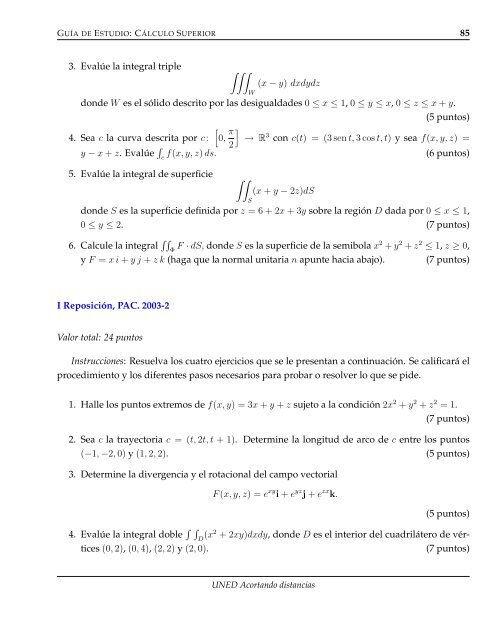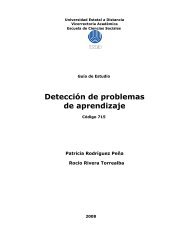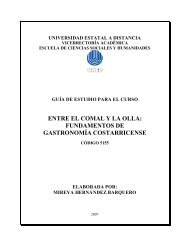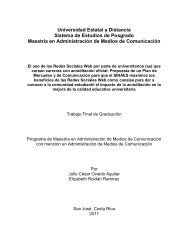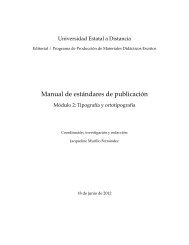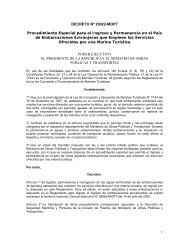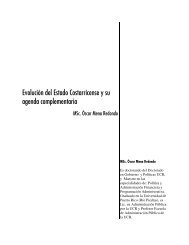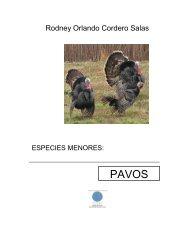GE3011 Cálculo Superior - Repositorio de la Universidad Estatal a ...
GE3011 Cálculo Superior - Repositorio de la Universidad Estatal a ...
GE3011 Cálculo Superior - Repositorio de la Universidad Estatal a ...
Create successful ePaper yourself
Turn your PDF publications into a flip-book with our unique Google optimized e-Paper software.
GUÍA DE ESTUDIO: CÁLCULO SUPERIOR 85<br />
3. Evalúe <strong>la</strong> integral triple <br />
W<br />
(x − y) dxdydz<br />
don<strong>de</strong> W es el sólido <strong>de</strong>scrito por <strong>la</strong>s <strong>de</strong>sigualda<strong>de</strong>s 0 ≤ x ≤ 1, 0 ≤ y ≤ x, 0 ≤ z ≤ x + y.<br />
(5 puntos)<br />
<br />
4. Sea c <strong>la</strong> curva <strong>de</strong>scrita por c: 0, π<br />
<br />
→ R<br />
2<br />
3 con c(t) = (3 sen t, 3 cos t, t) y sea f(x, y, z) =<br />
y − x + z. Evalúe <br />
f(x, y, z) ds. (6 puntos)<br />
c<br />
5. Evalúe <strong>la</strong> integral <strong>de</strong> superficie <br />
(x + y − 2z)dS<br />
S<br />
don<strong>de</strong> S es <strong>la</strong> superficie <strong>de</strong>finida por z = 6 + 2x + 3y sobre <strong>la</strong> región D dada por 0 ≤ x ≤ 1,<br />
0 ≤ y ≤ 2. (7 puntos)<br />
6. Calcule <strong>la</strong> integral <br />
Φ F · dS, don<strong>de</strong> S es <strong>la</strong> superficie <strong>de</strong> <strong>la</strong> semibo<strong>la</strong> x2 + y 2 + z 2 ≤ 1, z ≥ 0,<br />
y F = x i + y j + z k (haga que <strong>la</strong> normal unitaria n apunte hacia abajo). (7 puntos)<br />
I Reposición, PAC. 2003-2<br />
Valor total: 24 puntos<br />
Instrucciones: Resuelva los cuatro ejercicios que se le presentan a continuación. Se calificará el<br />
procedimiento y los diferentes pasos necesarios para probar o resolver lo que se pi<strong>de</strong>.<br />
1. Halle los puntos extremos <strong>de</strong> f(x, y) = 3x + y + z sujeto a <strong>la</strong> condición 2x 2 + y 2 + z 2 = 1.<br />
(7 puntos)<br />
2. Sea c <strong>la</strong> trayectoria c = (t, 2t, t + 1). Determine <strong>la</strong> longitud <strong>de</strong> arco <strong>de</strong> c entre los puntos<br />
(−1, −2, 0) y (1, 2, 2). (5 puntos)<br />
3. Determine <strong>la</strong> divergencia y el rotacional <strong>de</strong>l campo vectorial<br />
F (x, y, z) = e xy i + e yz j + e zx k.<br />
(5 puntos)<br />
<br />
4. Evalúe <strong>la</strong> integral doble D (x2 + 2xy)dxdy, don<strong>de</strong> D es el interior <strong>de</strong>l cuadrilátero <strong>de</strong> vértices<br />
(0, 2), (0, 4), (2, 2) y (2, 0). (7 puntos)<br />
UNED Acortando distancias


